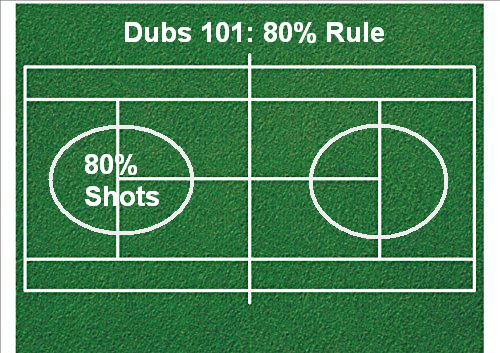MTC Ladies Tuesday Results
Results posted for Round 5.
Results posted for Round 5.

Great to see a slow and steady improvement in our players in our Ladies Clinics practicing these tips.
Cheers,
The Tennis Whisperer
Djokovic won his 17th Grand Slam at the Australian Open. And while I’m not a fan, there are some key lessons for us tragics!
Conventional wisdom tells us that on big points, we should play to our strengths. Djokovic admitted that when the big points came in the AO final, he did the opposite. Both times this baseliner rushed the net, and both times he came up trumps with the backhand volley he needed. [Coach Goran believes stats can sometimes be overrated particularly on big points and has caused Federer to lose two Slams.]
What does that tell us? That Djokovic has a strategic sixth sense? That fortune favors the brave? I would say it shows that in tennis, execution is underrated. By making those crucial volleys, Djokovic turned a tactic that was at best counterintuitive, and at worst reckless, into a winning one. And he turned what easily could have been his third straight loss to Thiem into his 17th Grand Slam title.
Champions execute, and, yes, while it may not be as simple as it sounds, they do rise to the occasion. In his own complicated way, Djokovic proved it again last night.
Paraphrasing Tennis Magazine, here’s how the match unfolded…..
In the first set, he tried for an early knockout punch. He took the ball early, peppered Thiem’s backhand, and broke the Austrian in his first service game. Thiem got off the mat and broke back, but Djokovic won the set anyway with a brilliant stab return, and a Thiem double-fault, at 4-5.
At that point, you might have expected a player of Djokovic’s stature and experience to relax and run away with a straight-set victory. That’s essentially what he did against Roger Federer in the semis. Instead, he spent the next two sets running out of gas. Thiem was the guy who had worked harder and longer to get here, but it was Djokovic who was suddenly dazed, slump-shouldered, and staggering, and who needed a refrigerator’s worth of food and drinks to revive him.
“Turbulent, I would say,” is how Djokovic described his evening.
“It started off really well; I broke his serve right away. I felt the experience on my side playing many Australian Open finals. For him, it was his first.”
“After I lost the second set, I started to feel really bad on the court. My energy dropped significantly. To be honest, I still don’t understand the reason why that has happened, because I’ve been doing the things I’ve been doing before all may matches. I was hydrated well and everything. Apparently doctor said I wasn’t hydrated enough.”
Like Nadal in New York, though, Djokovic found a way to right himself just in time. The fluids kicked in during the fourth set, and his body language and stamina immediately improved. From that point on, Djokovic went back to doing what he does best: digging in and forcing his opponent to hit a perfect shot, and then another, and then another. Thiem, whether it was because he finally grew tired or finally tensed up, began to misfire on his biggest weapon, his forehand. He made Djokovic work to the bitter end, but he could never get his nose in front again.
“He was a better player,” Djokovic said of Thiem. “Probably one point and one shot separated us tonight. Could have gone a different way.”
Djokovic then alluded to the two most important moments in the match: The break points that he saved early in each of the last two sets, and that kept the momentum on his side of the net. Djokovic saved them both in the same, completely unexpected way: with a surprise run to the net.
“I served and volleyed when I was facing break point in the fourth and in the fifth,” Djokovic said. “It worked both of the times. It could also have been differently. Serve and volley is not something I’m accustomed to. I’m not really doing that that often.”
“I kind of recognized that as an important tactic in those circumstances, and I’m really happy it worked.”
Source: https://www.tennis.com/pro-game/2020/02/novak-djokovic-australian-open-turbulent-triumphant-17th-major-champion-rise/87312/
While men’s singles is dominated by the Big Three of Novak Djokovic, Rafael Nadal and Roger Federer, it is anyone’s game on the women’s side.
Sofia Kenin won the Australian Open, becoming the eighth woman to win a Grand Slam championship for the first time in the last 12 tournament.
……..
Perhaps the heart — and a tremendous amount of practice and conditioning — helps explain why men in their 30s continue to dominate. Younger stars like Dominic Thiem have to know in their heads by now that they have the firepower and skills to rival the Big Three: Djokovic, Rafael Nadal and Roger Federer.
Thiem, 26, has beaten each of them on more than one surface and has beaten Nadal and Djokovic in best-of-five-set Grand Slam play. But he is now 0-3 in Grand Slam finals after his loss to Djokovic late Sunday night.
It was a five-setter that was more epic in length than mood, with Thiem failing to push Djokovic for long at the end of the fourth set or the fifth. The suspense never approached the high-anxiety levels of last year’s Wimbledon final, when Djokovic beat Federer in a tiebreaker after they won 12 games each in the fifth set, a first for a Wimbledon final. Sunday’s duel also fell short of the five-set United States Open final in September, when Daniil Medvedev, 23, rallied from two sets down to push Nadal remarkably close to his physical limits.
But the theme remained the same: the old guard holding off new blood, though now just barely.
“I think it’s only small details,” Thiem said. “It could have gone either way for Daniil in the U.S. Open and for me here.”
The blockade of Grand Slam ports is still real.
“It’s unique in sports history that the three best players by far are playing in the same era,” Thiem said. “That’s what makes it very, very difficult for players to break through.”
Race walkers on a low-carbohydrate, high-fat ketogenic diet showed early signs indicative of bone loss.
A low-carbohydrate, high-fat ketogenic diet could alter bone health in athletes, according to a thought-provoking new study of elite race walkers and their skeletons. The study, one of the first to track athletes during several weeks of intense training, finds that those following a ketogenic diet developed early signs indicative of bone loss.
The study adds to the considerable existing evidence that how we eat can affect how exercise affects us. It also raises concerns about possible, long-term health impacts from popular diet plans, including a high-fat, ketogenic diet.
Anyone interested in health, wellness, weight loss, exercise, food or best seller lists is familiar, by now, with ketogenic diets. Known more familiarly as keto diets, they are extremely low-carbohydrate, high-fat regimens, with as much as 90 percent of daily calories coming from fats.
Ketogenic diets, if followed scrupulously, reshape how our bodies fuel themselves. Because carbohydrates can be rapidly metabolized, our bodies typically turn to them first for energy, whether the carbohydrates come from our diets or stored sources in our muscles and livers.
But if people follow a low-carbohydrate, ketogenic diet, they soon burn through their stored carbohydrates and their bodies start relying on fat for energy. The fat must be broken down first, however, and, as part of that process, the liver creates substances known as ketone bodies that can be converted into energy.
Ketogenic diets are popular now — as they have been off and on in the past — among people hoping to lose weight, control blood sugar or otherwise regulate their health. Some athletes also follow the diet, hoping that it will improve performance, since fat, as fuel, is ample, slow-burning and long-lasting.
By Gretchen Reynolds NYTimes Read more –>
MTC announces its Tennis Whisperer Ladies clinics.
For Term 1, we have two Ladies Clinics:
1) Monday Ladies Clinic 9:00 – 10:30 am
2) Wednesday Ladies Clinic 9:00 – 10:30 am
Numbers are limited and players must meet a minimum playing standard. Other Whisperer clinics may be held upon request.
MTC charges $30 for our Tennis Whisperer clinics.
Click here to learn more about, and sign up for, our Tennis Whisperer program.
Helping you to play better with the skills that you already have is the primary goal of our Tennis Whisperer program. In this missive, we focus on overcoming your natural dominance, and in particular your feet.
We’re hard-wired neurologically from birth to being right- or left-handed. We prefer using one dominant hand, and for most of us, one eye. And when we first learned tennis, our coach inadvertently focused on our dominance.
What isn’t well-known, however, is that you can be right-handed but have a dominant left foot or left eye — “cross-dominance.”
Forehands are preferred if you’re right-handed and left-eyed (or vice versa) because you can stroke the ball comfortably in the sight of the dominant eye. Backhands are a challenge though. Right-handed, left-eyed players, for example, sometimes lose the correct backhand stance, because they have to turn to keep sight of the ball. The ‘fix’ so to speak is to open up your stance to take away your eye dominance.
While strength training can build muscle on your nondominant side to improve your balance, strength training will not address the eye, hand and foot coordination required to consistently hit a tennis ball well.
But what about return of serve which requires you to move to the ball from a standing start while maintaining your balance? Foot cross dominance is now key, effecting your stance, stroke and footwork.
In our short video below, we show you how to build the neural pathways to ‘balance out’ your foot dominance. Notice how our model, Pamela, uses a basic crossover step to trap the ball on either side. Note, a partner is probably preferred but you can use a wall if you want to practice alone.
Remember to start slow, and be patient with yourself. It takes time to repave the neural pathways, particularly if you’ve played for many years.
The good news: you can teach an older dog new tricks. And remember, have fun while you’re learning your new tricks.
The Tennis Whisperer

My game is reasonably developed. So ….
Why is it so difficult to make my serve more reliable?
Why can’t I improve my backhand?
Why do I miss easy volleys?
I just don’t know when to pull the trigger on a ground stroke!
Just ask the Tennis Whisperer. Scan the bar code with your phone camera app to find out about this new and exciting MTC program.

Or log onto MTC Tennis Whisperer.
JANUARY 20, 2020
is perfect hair held by a perfect headband against a pressed polo shirt, Roger Federer walked on to centre court at the Queensland Tennis Centre for his first tournament of 2014 to an adoring crowd.
A real-life glimpse of Federer was enough to transfix even the most casual tennis fan but, on this occasion, if you were in the know, it was his equipment that would have held your attention as much as the tennis God himself.
Federer had broken with a decade of tradition and got himself a new racquet.
The whole of 2013 had been a career low for the Swiss champion. Usually No.1 or No.2 in the world, he’d ended the year ranked sixth. A premature exit from Wimbledon, in the second round, had marked the first time in 36 consecutive grand slams that he had not made a quarter-final. He’d lasted until just the fourth round in the US Open, a tournament he’d won five times before.
These results represented, in the minds of some, the start of a career plateau for the then-32-year-old, with back injuries among the factors blunting his dominance.
But Federer arrested the slide.
He hired a new coach – his childhood hero, six-time grand-slam winner Stefan Edberg. He set about mending his body. And, perhaps less obviously until he appeared on court in Brisbane, he changed his magic wand – the racquet he’d wielded through his rise to tennis legend.
For a certain weekend warrior type of tennis player, changing racquets might offer a seductive solution to a subpar game. After all, it’s easier to spend a few hundred dollars on new equipment than it might be to work on a weak backhand or sluggish legs.
And a change can’t do much harm, right?
At the elite level, there is nowhere to hide. Just as any adjustment in stroke will be identified and perfected so will every variable gram, inch or centimetre in a racquet be scrutinised. The racquet is the player’s key weapon and one with which he or she has a symbiotic relationship. If a change is to be made to this set-up, it will be for good reason. And even an improvement of 1 per cent is a good reason in international tennis.
For Federer, at that moment in Brisbane, the stakes could not have been higher.
More recently, in the lead-up to this year’s Australian Open, eagle-eyed fans might have noticed that Serena Williams has stepped out with a new racquet.
How do stars such as Federer, his on-court arch rival Rafael Nadal and Barty and Williams set up their racquets to boost their games? And how have changes in racquets over the years changed the game itself?
Nadal found an extra gear to cruise to a comfortable 6-1 win in the deciding set.
And De Minaur had the chance to see first hand what it takes to make a top-10 player, with Nadal explaining how he had turned the match around.
“Well, you need to have the mind open and clear to find solutions, and I was not able to win many points on the return during all the second set,” Nadal said. “I needed to change something, and that’s what I did.
“I think I advanced my position around one metre, one metre and a half on the return, on the deuce especially, and I take the first point. And then game change, because then the pressure is on the other side of the court.
“So just tried to change a little bit the dynamic, tried to change a little bit the energy of the match in that moments and tried to make feel the opponent something different that is not going the same way that have been going for the last 30 minutes.
“So that’s what I tried. And today it worked.”
Source: SMH
Recent studies show that foot fitness—and these 5 exercises—can help prevent bunions and plantar fasciitis, ward off shin splints, and, quite possibly, save your life.
If you’re like most people, you probably do not spend a ton of time, if any, thinking about the muscles in your feet. In fact, you likely can’t even name them. Think about it: You know your biceps and triceps are in your upper arms. You’re certainly aware that the front side of your thighs is your quads, and the back sides are your hamstrings. But the muscles that lets you lift your big toe and press it against the ground, that’s called…uh….the, um…
Abductor hallucis is the phrase you’re looking for. You were just about to say that, right? You can group it in with a larger formation of muscles known as the plantar intrinsics, a not-particularly-well-understood group that both begin and end within the confines of the foot.
Only recently, researchers have been able to take a detailed look at what, exactly, these muscles do. Among those leading the charge is Luke A. Kelly, PhD, a biomechanics research fellow at the University of Queensland in Australia. His work over the past five years has shown that the plantar intrinsics play a crucial role in maintaining balance, especially when you are standing on one leg.
Why is this important? One of the biggest risks you’ll face during your life is falling. In fact, falls are the number one cause of injuries and death among older Americans. Whether you’re a senior or a millennial (or somewhere in between), those tiny-but-crucial muscles in your foot that keep you upright are getting weaker by the moment. A recent study released in March 2017 examined toe flexor (part of the plantar intrinsics) strength in more than 1,400 men and found it was a good indicator of one’s body composition and metabolic health. It also showed that an age-related decline in strength developed earlier in the toe flexors than it did the grip (another effective predictor of a long, healthy life), and that strength dropped more sharply.
All of which is to say that the little muscles in your feet are a bigger deal than you think, and not just because weak plantar intrinsics have been linked to bunions, plantar fasciitis, and shin splints (although all of this is true). The strength of your feet and toes is reflective of your strength overall.
Here are five foot-strengthening exercises that help counteract the dysfunctional loading of our feet, restore them to their proper alignment, and strengthen the muscles helping to keep you upright.
MTC’s Proshop just took delivery of a new stringing machine.
This is a perfect time for anyone looking to get ready for the upcoming competition season to have their racquets restrung.
MTC is offering a $5.00 discount to all Club Members who have their racquets strung between now and 31st Jan. This includes any of our string range and as well as anyone suppling their own strings ie labour cost $25 instead of $30.
Corner Belgrave & Raglan Streets
Manly NSW 2095
